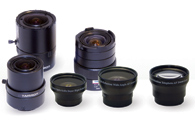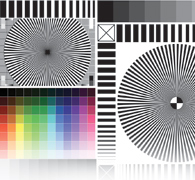
Products
Accessories

Optical components and lenses
One of the most important features of any camera is the quality of the image. It depends on the choice of optics and image sensor and on the processing power, as well as on the algorithms in the processing chip. No matter how good the digital or conventional camera is, it cannot produce high quality images, if it does not start with a good lens.
The choice of lens is very important in the process of developing of video sureillance systems. It is dependent on the characteristics of the application. The manufacturers rarely give information about the quality of the images. We at PixEye measure most of the lens characteristics - the resolution, distortion and colour reproduction of the lenses.
We choose for you the most appropriate lenses for different kind of cameras and applications. We have rich variety of lenses and optical elements at disposal.
Here some of the characteristics of some of the models:
Tamron 13VM2812ASII, Tamron 13VM308AS, Tamron M13VM246, Tamron M13VM550.
- Varifocal 2.8 - 12 mm
- Manual iris, aperture F/1.4 to close
- Angle of view at 1/3" sensor (HxV)
- Wide (2.8 mm): 97.4° x 72.5°
- Tele (12 mm): 24.1° x 18.1°
- CS mount
- Weight: 67g
- Varifocal 3.0 - 8 mm
- Manual Iris, aperture F/1.0 to close
- Angle of view at 1/3" sensor (HxV)
- Wide: 91° x 67°
- Tele: 36° x 27°
- CS mount
- Weight: 38.4g
- Varifocal 2.4 - 6 mm
- Manual Iris, aperture F/1.2 to close
- Angle of view at 1/3" sensor (HxV)
- Wide: 111.3° x 83.5°
- Tele: 47.1° x 35.4°
- CS mount
- Weight: 65g
- Varifocal 5 - 50 mm
- Manual Iris, aperture F/1.4 to close
- Angle of view at 1/3" sensor (HxV)
- Wide: 53.8° x 40.3°
- Tele: 5.5° x 4.2°
- CS mount
- Weight: 64g
Lens characteristics
- Focal length The focal length of the lens is defined as the distance from the middle of the lens to its focal point. Lenses are usually categorized as wide-angle, normal or telephoto by their focal length.
- Focal ratio This is the relationship between the diameter of a lens and its focal length.
- The quality of the image depends on aberations, Modulation Transfer Function (MTF), resolution, colour reproduction and etc.
- Resolution The number of lines (black and white) per one milimeter in an image which can be clearly distinguished.
The perfect combination between sensor and lens is both to have the same resolution. This is achievable by some of the megapixel photo cameras. By the security cameras even the best megapixel lenses have a lower resolution than the resolution of the camera.





